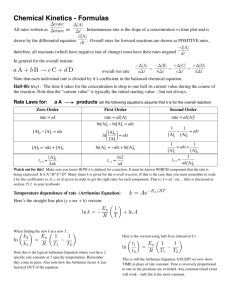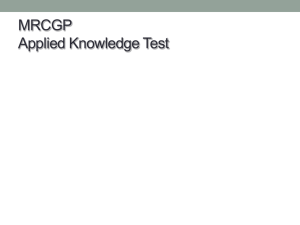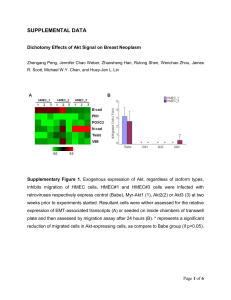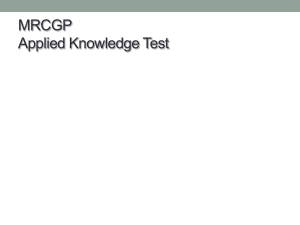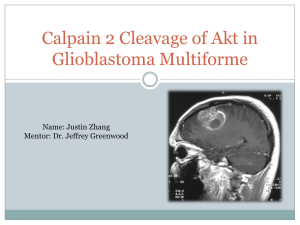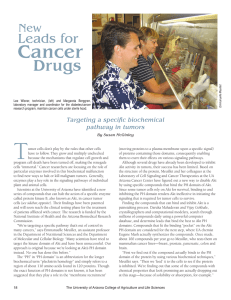Aberrant AKT activation drives well-differentiated liposarcoma Please share
advertisement
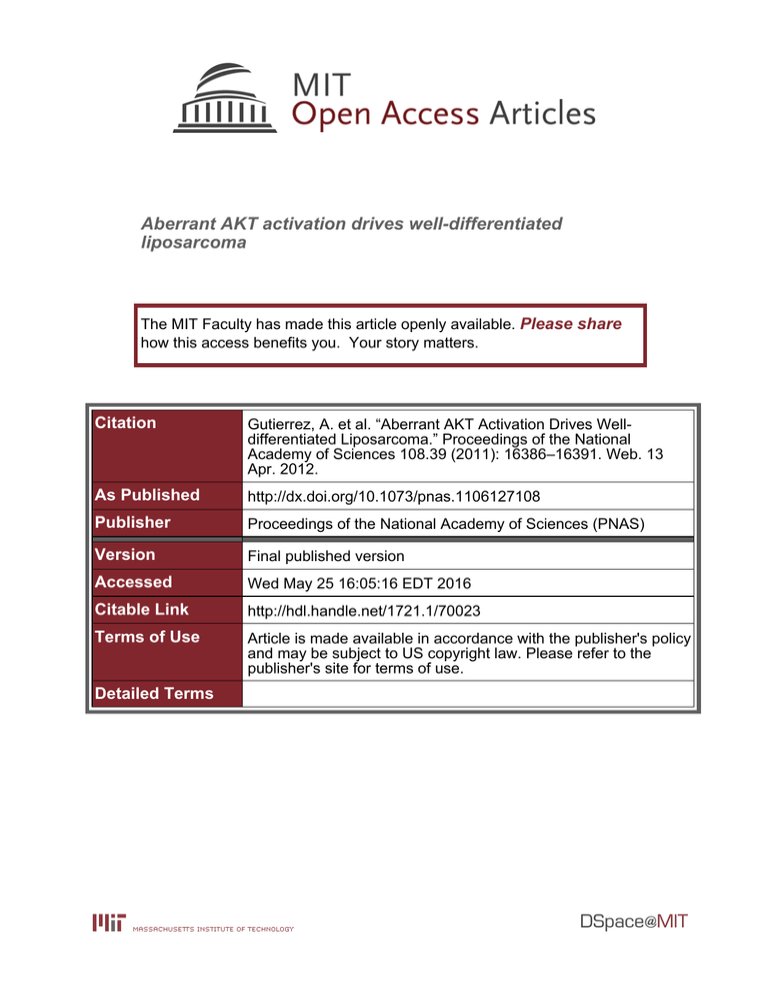
Aberrant AKT activation drives well-differentiated liposarcoma The MIT Faculty has made this article openly available. Please share how this access benefits you. Your story matters. Citation Gutierrez, A. et al. “Aberrant AKT Activation Drives Welldifferentiated Liposarcoma.” Proceedings of the National Academy of Sciences 108.39 (2011): 16386–16391. Web. 13 Apr. 2012. As Published http://dx.doi.org/10.1073/pnas.1106127108 Publisher Proceedings of the National Academy of Sciences (PNAS) Version Final published version Accessed Wed May 25 16:05:16 EDT 2016 Citable Link http://hdl.handle.net/1721.1/70023 Terms of Use Article is made available in accordance with the publisher's policy and may be subject to US copyright law. Please refer to the publisher's site for terms of use. Detailed Terms Aberrant AKT activation drives well-differentiated liposarcoma Alejandro Gutierreza,b,1, Eric L. Snyderc,d,e,f, Adrian Marino-Enriquezc, Yi-Xiang Zhangf,g, Stefano Sioleticf,g, Elena Kozakewicha, Ruta Grebliunaitea, Wen-bin Ouc, Ewa Sicinskad,f, Chandrajit P. Rautg,h, George D. Demetrif,g, Antonio R. Perez-Ataydei, Andrew J. Wagnerf,g, Jonathan A. Fletcherc,g, Christopher D. M. Fletcherc, and A. Thomas Looka,b,1 a Department of Pediatric Oncology, dDepartment of Medical Oncology and Center for Molecular Oncologic Pathology, fThe Ludwig Center at Dana-Farber/ Harvard Cancer Center, and gCenter for Sarcoma and Bone Oncology, The Dana-Farber Cancer Institute, MA 02215; bDivision of Hematology/Oncology, i Department of Pathology, Children’s Hospital, Boston, MA 02115; cDepartment of Pathology and hDepartment of Surgery, Brigham and Women’s Hospital, Boston, MA 02115; and eThe Koch Institute for Integrative Cancer Research, Massachusetts Institute of Technology, Cambridge, MA 02139 Edited* by Dennis A. Carson, University of California at San Diego, La Jolla, CA, and approved August 15, 2011 (received for review April 21, 2011) Well-differentiated liposarcoma (WDLPS), one of the most common human sarcomas, is poorly responsive to radiation and chemotherapy, and the lack of animal models suitable for experimental analysis has seriously impeded functional investigation of its pathobiology and development of effective targeted therapies. Here, we show that zebrafish expressing constitutively active Akt2 in mesenchymal progenitors develop WDLPS that closely resembles the human disease. Tumor incidence rates were 8% in p53 wild-type zebrafish, 6% in p53 heterozygotes, and 29% in p53homozygous mutant zebrafish (P = 0.013), indicating that aberrant Akt activation collaborates with p53 mutation in WDLPS pathogenesis. Analysis of primary clinical specimens of WDLPS, and of the closely related dedifferentiated liposarcoma (DDLPS) subtype, revealed immunohistochemical evidence of AKT activation in 27% of cases. Western blot analysis of a panel of cell lines derived from patients with WDLPS or DDLPS revealed robust AKT phosphorylation in all cell lines examined, even when these cells were cultured in serum-free media. Moreover, BEZ235, a small molecule inhibitor of PI3K and mammalian target of rapamycin that effectively inhibits AKT activation in these cells, impaired viability at nanomolar concentrations. Our findings are unique in providing an animal model to decipher the molecular pathogenesis of WDLPS, and implicate AKT as a previously unexplored therapeutic target in this chemoresistant sarcoma. L iposarcoma is the most common sarcoma of humans, affecting ∼2,000 individuals per year in the United States (1). These tumors are classified into five histopathologic subtypes, with well-differentiated liposarcoma (WDLPS) accounting for ∼50% of cases, and dedifferentiated liposarcoma (DDLPS), a closely related subtype that appears to arise from further malignant progression of WDLPS, accounting for an additional 9% to 18% of cases (1–3). Liposarcomas are generally thought to arise de novo rather than from preexisting benign lesions, and most patients lack recognized causative factors. Although complete surgical resection can be curative, WDLPS often develops in deep anatomic locations, such as the retroperitoneum or mediastinum, where its propensity to enwrap vital structures typically makes complete surgical resection difficult or impossible, leading to high morbidity and mortality rates (1, 4). Radiation and chemotherapy have limited efficacy in the treatment of WDLPS (5, 6). Indeed, there are no systemic therapeutic regimens known to improve survival when complete surgical resection is not feasible, underscoring the need for an improved molecular understanding of WDLPS to stimulate the development of effective targeted therapies. The MDM2-p53 pathway plays a prominent role in WDLPS pathogenesis, with the vast majority of human tumors harboring either MDM2 amplifications or p53 mutations (6–10). Moreover, individuals with germ-line p53 mutations appear to be at increased risk of WDLPS development at a very young age (11). 16386–16391 | PNAS | September 27, 2011 | vol. 108 | no. 39 Regions of chromosome 12q13-15 are often amplified in welldifferentiated and dedifferentiated liposarcomas, typically involving MDM2, CDK4, and HMGA2, along with several other genes (6, 10, 12, 13); JUN can also be amplified in WDLPS cases that have a dedifferentiated component (14). Further dissection of WDLPS molecular pathogenesis has been greatly impeded by the lack of animal models suitable for experimental analysis. Oncogenic signal transduction through the PI3K-AKT pathway, which is widely dysregulated in human cancer, is normally down-regulated by the PTEN tumor suppressor (15). Individuals with germ-line PTEN-inactivating mutations frequently develop multiple lipomas (benign adipocytic neoplasms) (16), and AKT activation has been described in human liposarcomas (17), suggesting that the PI3K-AKT pathway is involved in adipocyte transformation. Here we show that expression of constitutively active Akt2 in zebrafish mesenchymal progenitors induces WDLPS, thus being unique in providing an animal model for future investigation of this disease. Moreover, we also show that AKT pathway inhibition impairs viability in human cell lines derived from patients with WDLPS and DDLPS, thus implicating AKT as a previously unexplored therapeutic target in these chemoresistant sarcomas. Results Expression of Constitutively Active Akt2 Induces Well-Differentiated Liposarcoma. To test the hypothesis that Akt is a WDLPS onco- gene that collaborates with p53 inactivation during adipocyte transformation, we in-crossed zebrafish harboring heterozygous p53M214K mutations, which encode a transactivation-defective p53 protein (18), and all resultant embryos were microinjected at the one-cell stage with a rag2:myr-mAkt2 expression construct (Fig. 1A). This construct encodes a myristoylated, constitutively active mouse Akt2 transgene (19) driven by a zebrafish rag2 Author contributions: A.G., E.L.S., A.M.-E., W.-b.O., J.A.F., C.M.D.F., and A.T.L. designed research; A.G., E.L.S., A.M.-E., Y.-X.Z., S.S., E.K., R.G., and W.-b.O. performed research; E.L.S., S.S., E.S., C.P.R., G.D.D., A.J.W., J.A.F., and C.M.D.F. contributed new reagents/analytic tools; A.G., E.L.S., A.M.-E., Y.-X.Z., S.S., E.K., W.-b.O., C.P.R., G.D.D., A.R.P.-A., J.A.F., C.M.D.F., and A.T.L. analyzed data; and A.G. and A.T.L. wrote the paper. Conflict of interest statement: C.P.R. is a consultant for Novartis and participates in clinical trials of Novartis. G.D.D. is a consultant for Novartis, Pfizer, Ariad, Johnson & Johnson, PharmaMar, Genentech, Infinity Pharmaceuticals, EMD-Serono, Glaxo Smith Kline, Amgen, Daiichi-Sankyo, ArQule, Enzon, Millenium/Takeda; is a member of the scientific advisory board of Plexxikon, ZioPharm, Nereus, N-of-One, and Kolltan Pharmaceuticals; and participates in clinical trials of Novartis, Pfizer, Ariad, Johnson & Johnson, PharmaMar, and Infinity Pharmaceuticals. A.J.W. is a consultant for Novartis, Roche/Genentech, Sanofi, Pfizer, EMD-Serono, and participates in clinical trials supported by Novartis, Roche/Genentech, Pfizer, and Exelixis. *This Direct Submission article had a prearranged editor. 1 To whom correspondence may be addressed. E-mail: thomas_look@dfci.harvard.edu or Alejandro_Gutierrez@dfci.harvard.edu. This article contains supporting information online at www.pnas.org/lookup/suppl/doi:10. 1073/pnas.1106127108/-/DCSupplemental. www.pnas.org/cgi/doi/10.1073/pnas.1106127108 promoter fragment that drives ectopic expression in mesenchymal progenitors (20). Zebrafish injected with rag2:myr-mAkt2 developed externally visible solid tumors between 1 and 4 mo of age; the tumor incidence rates were 29% in p53-homozygous mutants, 6% in p53 heterozygotes, and 8% in their p53 wild-type siblings (P = 0.01) (Fig. 1 B and C). Histologic analyses revealed that 91% of these tumors consisted of locally invasive masses of adipocytes showing considerable variation in cell size, together with scattered atypical stromal cells with hyperchromatic nuclei and lipoblasts characterized by multivacuolated cytoplasm and large hyperchromatic pleomorphic nuclei, findings that are diagnostic of WDLPS in humans (Fig. 1 D–F) (2), whereas the remaining 9% of tumors were osteosarcomas, as described below. Immunohistochemical analysis revealed strong reactivity for phospho-AKT(Ser473) in the tumor cells of rag2:myr-mAkt2 transgenic zebrafish but not in the normal fat of control rag2: GFP transgenic fish, indicating expression of the constitutively active Akt2 transgene (Fig. 1 G–I). Moreover, none of the control p53-homozygous mutant zebrafish injected with rag2:GFP (n = 60) developed tumors by 6 mo of age. In addition, one p53-homozygous mutant injected with rag2: myr-mAkt2 developed a rigid mass at the base of the dorsal fin wt/mut tion is also involved in human liposarcoma pathogenesis, we performed immunohistochemical analysis for phospho-AKT (Ser473) on clinical specimens from 58 patients with well-differentiated and dedifferentiated liposarcomas. These studies demonstrated AKT activation in a subset of the human WDLPS or DDLPS cases (Fig. 3 A–F), including 22% of the pure WDLPS (n = 23) and 46% of pure DDLPS (n = 13) tumors analyzed (Fig. 3J). We also included human tumors containing both well-differentiated and dedifferentiated liposarcoma components in our analysis (n = 22), which revealed phospho-AKT positivity in 32% of the well-differentiated components and 45% in the dedifferentiated components of these cases (Fig. 3J). Given that phospho-AKT is a labile epitope in clinical speci- B X tp53 Aberrant AKT Pathway Activation in Primary Human Well-Differentiated and Dedifferentiated Liposarcomas. To test whether AKT activa- tp53 wt/mut Inject: rag2 promoter- myr Assess Tumor Onset mAkt2 Genotype Solid Tumor Incidence (%) A that demonstrated increased lobulation and vascularity compared with the WDLPS tumors (Fig. 2 A and B). Histologic analysis revealed that this mass consisted predominantly of osteoid interspersed with large malignant cells characterized by pleomorphic nuclei, features that are diagnostic of osteosarcoma in humans (Fig. 2 C and D) (2). P = 0.013 30 p53 mut/mut (n=21) p53 mut/wt (n=52) p53 wt/wt (n=25) 20 10 0 0 2 4 6 Age (months) 8 C Control Well-Differentiated Liposarcoma E F G H I Fig. 1. Constitutive Akt activation drives WDLPS in the zebrafish. (A) Experimental design. (B) Solid tumor incidence in p53 wild-type, heterozygous, or p53M214K homozygous mutant siblings injected with a rag2:myr-mAkt2 transgene at the one-cell stage. P value calculated via log-rank test. (C) Representative rag2:myrmAkt2-injected zebrafish, which developed what appear to be two independent solid tumors. The animal shown was p53-homozygous mutant. (Scale bar, 5 mm.) Note that the image shown in (C) consists of merged adjacent photomicrographs. (D) Control H&E-stained zebrafish section. Arrow points to normal subcutaneous adipocytes. (E) Low-magnification view of an H&E section through the zebrafish shown in C, demonstrating a locally invasive mass consisting of well-differentiated adipocytes with significant variation in cell size. (F) High-magnification view of H&E section demonstrating a representative lipoblast scattered throughout these tumors, characterized by a multivacuolated cytoplasm and large hyperchromatic pleomorphic nuclei. (G) Phospho-AKT immunohistochemistry on a control zebrafish section. Arrow points to normal subcutaneous adipocytes, which lacked detectable pAKT staining. (H and I) Phospho-AKT immunohistochemistry on tumor sections from the zebrafish shown in C, revealing strong immunoreactivity for phospho-AKT in tumor cells of rag2:myr-mAkt2transgenic zebrafish. (Scale bars, 100 μm.) Gutierrez et al. PNAS | September 27, 2011 | vol. 108 | no. 39 | 16387 MEDICAL SCIENCES phospho-AKT H&E D A demonstrating evidence of S6 activation (Fig. 3K). We found no immunohistochemical evidence of AKT or S6 phosphorylation in lipomas or in normal adipose tissue (Fig. 3 D and G, and Fig. S1). To determine whether AKT activation is aberrant in human WDLPS and DDLPS, we took advantage of a panel of cell lines derived from patients with these sarcomas to evaluate phosphorylation of AKT and of its downstream target GSK3β after 4 h of growth in serum-free conditions. Strikingly, Western blot analysis revealed persistent phosphorylation of AKT and of its downstream target GSK3β in all eight cell lines examined, even under such serum-starved conditions. In contrast, serum starvation resulted in silencing of AKT and GSK3β phosphorylation in control SU-CCS-1 clear cell sarcoma cells (Fig. 4). B C D Fig. 2. Osteosarcoma development in a rag2:myr-mAkt2-injected, p53-homozygous mutant zebrafish. (A and B) A p53-homozygous mutant zebrafish injected with the rag2:myr-mAkt2 expression construct developed a solid lobulated mass at the base of the dorsal fin. Note that the image shown in A consists of merged adjacent photomicrographs. (Scale bars, 1 mm.) (C and D) H&E-stained sections at low and high magnification, respectively, demonstrate a mass consisting predominantly of osteoid matrix interspersed with large malignant cells with pleomorphic nuclei, features that in humans are diagnostic of osteoblastic osteosarcoma. (Scale bars, 100 μm.) mens, we also performed immunohistochemistry for phospho-S6 (Ser235/236), a downstream target of the AKT pathway (21). Similar results (Fig. 3 G–I) were obtained, with 17% of pure WDLPS (n = 23), 41% of well-differentiated WDLPS/DDLPS components (n = 22), and 47% of DDLPS (pure DDLPS, n = 13; dedifferentiated WDLPS/DDLPS components, n = 21), Lipoma WDLPS PI3K-AKT-Mammalian Target of Rapamycin Pathway Inhibition Impairs the Viability of Human Liposarcoma Cells. To determine whether human WDLPS and DDLPS cells are dependent on aberrant AKT pathway activation, we treated four cell lines (two WDLPS and two DDLPS) with BEZ235, a dual-specificity inhibitor of PI3K and both mammalian target of rapamycin (mTOR) complexes (22) that effectively silences AKT pathway activation in these cells (Fig. 5A). BEZ235 treatment for 72 h decreased the viability of all cell lines tested, with IC50 values ranging from 13 to 75 nM (Fig. 5B). Treatment with rapamycin, an mTORC1 inhibitor, had less of an effect on viability (Fig. 5C), suggesting that the PI3K-AKT pathway plays both mTORC1dependent and -independent roles in the pathobiology of WDLPS and DDLPS. Analysis of cell-cycle profiles revealed that BEZ235 treatment induced G1 arrest at nanomolar concentrations (Fig. 5D), whereas apoptosis was induced only at a 1-μM concentration (Fig. 5E). DDLPS B C D E F G H I 100 Negative Intermediate High 80 60 40 20 K pS6 IHC Staining (%) J pAKT IHC Staining (%) pS6 pAKT H&E A Negative Intermediate High 100 80 60 40 20 0 0 Pure WDLPS (n=23) Well-Diff (n=22) Dediff (n=22) Pure DDLPS (n=13) Cases with WDLPS & DDLPS components 16388 | www.pnas.org/cgi/doi/10.1073/pnas.1106127108 Pure WDLPS (n=23) Well-Diff (n=22) Dediff (n=21) Cases with WDLPS & DDLPS components Pure DDLPS (n=13) Fig. 3. AKT pathway activation in primary human well-differentiated and dedifferentiated liposarcomas. (A–C) H&E staining of human lipoma, WDLPS, and DDLPS specimens. (D–F) Immunohistochemistry for Ser473-phosphorylated AKT in a representative lipoma and AKT-positive WDLPS and DDLPS clinical specimens. (Scale bar, 100 μm.) (G–I) Immunohistochemistry for phospho-S6 ribosomal protein (Ser235/236) in a representative lipoma, as well as AKT-positive WDLPS and DDLPS clinical specimens. (J and K) Quantitation of phosphoAKT and phospho-S6 immunohistochemistry in pure WDLPS, pure DDLPS, and in human tumors with mixed well-differentiated and dedifferentiated liposarcoma components. Gutierrez et al. 1 2 3 4 5 6 A 7 Controls + 8 + p-GSK3β GSK3β GSK3β vinculin vinculin B Relative Cell Number p-GSK3β Gutierrez et al. 0 0 1 3 10 C 1.2 30 100 300 1000 AKT AKT 1 2 6 LP6 1.2 1.0 0.8 0.6 0.4 0.2 0 0 0.1 1 10 100 1 2 6 LP6 1.0 0.8 0.6 0.4 0.2 0 1000 0 0.1 BEZ235 (nM) D 1 10 100 1000 Rapamycin (nM) G2/M S G0/G1 E Early Apoptosis % of Cells 80 60 40 20 0 Late Apoptosis 15 100 % of Cells Discussion We have demonstrated that expression of activated Akt2 in mesenchymal progenitors drives WDLPS in transgenic zebrafish, and that nearly one-third of clinical specimens from primary cases of human WDLPS and DDLPS showed immunohistochemical evidence of AKT pathway activation. Moreover, treatment with the PI3K-AKT pathway inhibitor BEZ235 inhibited viability in all cell lines derived from patients with WDLPS and DDLPS that we tested. Taken together, our findings implicate a central role for oncogenic AKT signaling in the molecular pathogenesis of human WDLPS and DDLPS, and suggest the need for clinical trials of AKT pathway inhibitors in patients with unresectable disease, for whom there are currently no known effective therapies. Our analyses of primary human tumors revealed an increased frequency and intensity of staining for phospho-AKT and phosphoS6 ribosomal protein in dedifferentiated liposarcomas compared with their well-differentiated counterparts. These findings suggest the intriguing possibility that AKT activation may define a subset of WDLPS, which is particularly prone to dedifferentiation, a process that may be caused in part by the acquisition of additional oncogenic abnormalities further potentiating signaling through the AKT pathway. However, we cannot rule out the possibility that this apparent difference may simply be related to the greater difficulty of detecting phosphorylated epitopes in WDLPS sections, in which most of the tumor mass consists of large fat vacuoles within malignant yet well-differentiated adipocytes, whereas the densely cellular DDLPS tumors have a much greater number of cellular elements in which AKT phosphorylation can be assessed per section. Further studies will be required to establish the mechanisms underlying this observation. Recent work has revealed that 18% of myxoid/round-cell liposarcomas harbor activating mutations in PIK3CA, encoding the catalytic subunit of class IA PI3K (13). Myxoid/round-cell liposarcomas are characterized by t(12;16)(q13-14;p11) translocations, resulting in expression of TLS-CHOP fusion proteins, whereas these tumors lack the 12q amplifications characteristic of WDLPS/DDLPS, leading most investigators to believe that these liposarcoma subtypes are biologically distinct (1, 2). S6K1, a direct target of mTORC1 downstream of PI3K-AKT, has recently been shown to be required for the earliest stages of adipogenesis (23), providing one plausible mechanism to explain selection for AKT pathway activation in diverse liposarcoma subtypes. Nevertheless, the fact that expression of activated AKT in p53-mutant zebrafish drives development of WDLPS but not myxoid/round-cell liposarcomas indicates that AKT activation and p53 mutation can be early events in WDLPS pathogenesis, whereas expression of the TLS-CHOP fusion may be required in addition to PI3K-AKT pathway activation in the genesis of myxoid/round-cell liposarcomas. - p-AKT p-AKT Fig. 4. Aberrant AKT activation in human cell lines derived from patients with WDLPS and DDLPS. Western blot analysis for phosphorylation of AKT and its downstream target GSK3β was performed in a panel of cell lines derived from patients with WDLPS (samples 1–3) or DDLPS (samples 4–8), grown in serum-free conditions for 4 h before analysis. Control is the SU-SSC-1 clear-cell sarcoma cell line, shown in the presence and absence of serum. Sample 1 was run on both Western blots as a control for interblot variability. LP6 BEZ235 (nM) 10 5 0 0 1 3 10 30 100 300 1000 BEZ235 (nM) 0 30 100 300 1000 BEZ235 (nM) Fig. 5. PI3K-AKT-mTOR pathway inhibitors impair viability in human WDLPS and DDLPS cells. (A) Western blot analysis of the LP6 cell line, derived from a patient with DDLPS, demonstrating that BEZ235 effectively inhibits phosphorylation of AKT and its downstream target GSK3β at nanomolar concentrations. Positive and negative controls are the SU-SSC-1 cell line grown in the presence and absence of serum, respectively. (B) Viability of four cell lines derived from patients with WDLPS (cells 1 and 2) or DDLPS (cells 6 and LP6) was assessed after 72 h of BEZ235 treatment using the CellTiter-Glo luminescent cell viability assay. Values represent mean ± SEM (n = 3 replicates). IC50 values were 19, 32, 14, and 75 nM, respectively, for cells 1, 2, 6, and LP6. (C) Viability of WDLPS/DDLPS cell lines after 72 h of rapamycin treatment. (D) Effect of BEZ235 treatment on cell cycle distribution of LP6 cells examined by flow cytometry analysis at 24 h. Data shown are representative of two independent experiments. (E) Effect of BEZ235 treatment on apoptosis of LP6 cells, assessed by Annexin V and 7-AAD double-staining. Data shown are representative of two independent experiments. Current knowledge of the molecular pathogenesis of WDLPS has been driven by genetic analyses of human tumors, which have revealed that almost all cases harbor MDM2 amplification or TP53 mutations (7–10). Evidence also suggests that individuals with germ-line TP53 mutations are at increased risk of WDLPS development at a very young age (11). By demonstrating that activated Akt2 and p53 mutations collaborate in the zebrafish, we have now experimentally demonstrated the long-suspected role of p53 as a tumor suppressor in WDLPS. These tumors are also characterized by recurrent amplifications of distinct regions of chromosome 12q13-15 (6, 10, 12), but until now it has not been possible to identify which of the involved genes are WDLPS oncogenes driving the selection for these amplifications, and which are merely nonpathogenic “passengers.” Furthermore, although dedifferentiated liposarcoma is thought to arise because of further malignant transformation of WDLPS, it has previously been impossible to directly test the ability of candidate genetic lesions to drive this transformation in a physiological context. The zebrafish model we describe now provides a platform for experimental PNAS | September 27, 2011 | vol. 108 | no. 39 | 16389 MEDICAL SCIENCES 1 Serum DDLPS Relative Cell Number WDLPS Control studies to dissect molecular pathogenesis and discover novel therapeutic targets in this chemoresistant tumor. Inhibitors. BEZ235 and rapamycin were purchased from AXON Medchem and Calbiochem, respectively. Materials and Methods Western Blotting. Whole-cell lysates were prepared using lysis buffer (1% Nonidet P-40, 50 mM Tris-HCl pH 8.0, 100 mM sodium fluoride, 30 mM sodium pyrophosphate, 2 mM sodium molybdate, 5 mM EDTA, and 2 mM sodium orthovanadate) containing protease inhibitors (10 μg/mL aprotinin, 10 μg/mL leupeptin, and 1 mM phenylmethylsulfonyl fluoride). The lysates were then rocked overnight at 4 °C. Lysates were cleared by centrifugation at 16,100 × g for 30 min at 4 °C, and protein concentrations were determined with a Bio-Rad protein assay (Bio-Rad Laboratories). Equal amounts of protein were separated by SDS/PAGE, blotted to nitrocellulose membranes (Schleicher and Schuell) and then stained with the following antibodies: AKT (Cell Signaling Technology; #9272; 1:500), phospho-AKT(Ser473) (Cell Signaling Technology; #9271; 1:500), phospho-GSK3β(Ser9) (Cell Signaling Technology; #9336; 1:1,000), GSK3 (Santa Cruz; #sc-7291; 1:500), and vinculin (SigmaAldrich; #V4505; 1:500). The hybridization signals were detected by chemiluminescence (ECL, Amersham Biosciences) and captured using a LAS1000-plus chemiluminescence imaging system (Fujifilm). Zebrafish Husbandry, Mutant Lines, and Imaging. Zebrafish husbandry was performed as previously described (24), in accord with protocols approved by the Dana-Farber Cancer Institute Animal Care and Use Committee. The p53M214K-mutant zebrafish line was previously described (18). Zebrafish images were obtained using a Nikon SMZ1500 microscope, Nikon DS2MBWc camera, and NIS-Elements F Package Ver. 3.00 (Nikon Instruments Inc.). Expression Constructs. The rag2:myr-mAkt2 construct was generated by placing a myristoylated murine Akt2 transgene (19), which is constitutively activated as a result of constitutive membrane localization, downstream of a zebrafish rag2 promoter fragment (25) in a modified pBluescript vector, wherein the rag2:myr-mAkt2 construct is flanked by recognition sequences for I-SceI meganuclease. Generation of Transgenic Zebrafish. Circular rag2:myr-mAkt2 plasmid DNA (30 pg) was microinjected along with I-SceI meganuclease (New England Biolabs) into one-cell stage zebrafish embryos from the AB wild-type strain, as previously described (26). Zebrafish Paraffin Embedding and Sectioning. Zebrafish were killed in tricaine anesthetic, fixed in 4% paraformaldehyde at 4 °C for 2 d, decalcified with 0.25 M EDTA (pH 8.0) for 2 d, dehydrated in alcohol, cleared in xylene, and embedded in paraffin. Tissue sections from paraffin-embedded tissue blocks were placed on charged slides, deparaffinized in xylene, rehydrated through graded alcohol solutions, and stained with H&E or analyzed by immunohistochemistry. Patient Samples. Human well-differentiated liposarcoma, dedifferentiated liposarcoma, lipoma, and normal fat specimens were removed at surgery and collected from patients treated at Brigham and Women’s Hospital, who gave informed consent for use of anonymized surgical specimens for research purposes after all clinically relevant evaluations were performed, with approval of the Partners Health Care Institutional Review Board. The diagnosis of well-differentiated liposarcoma/atypical lipomatous tumor, dedifferentiated liposarcoma, or lipoma was made by institutional pathologists and reviewed by E.L.S. and C.D.M.F. to ensure diagnostic accuracy based on criteria of the World Health Organization (2). Immunohistochemistry. Immunohistochemistry on human samples was performed on a tissue microarray containing three 0.4-mm cores from each individual tumor, and on selected whole tumor sections. Zebrafish immunohistochemistry was performed on slides of whole zebrafish sections. Slides were deparaffinized and pretreated with 10 mM citrate (pH 6.0) in a steam pressure cooker (Decloaking Chamber, BioCare Medical) according to the manufacturer’s instructions, followed by washing in distilled water. Slides were pretreated with Peroxidase Block (Dako) for 5 min, followed by serumfree protein block (Dako) for 20 min. Primary rabbit antibody to Ser473 phospho-AKT (#4058; Cell Signaling Technology) or to Ser235/236 phosphoS6 ribosomal protein (#4858; Cell Signaling Technology) was applied at a 1:50 dilution in Antibody Diluent (Dako) and incubated at 4 °C overnight (phospho-AKT) or at room temperature for 1 h (phospho-S6). Anti-rabbit horseradish peroxidase-labeled polymer (Dako) was applied for 30 min. Immunoperoxidase staining was performed with diaminobenzidine (DAB)+ chromogen kit (Dako), according to the manufacturer’s instructions. Immunohistochemistry was independently scored by two pathologists (E.L.S. and S.S.), who then reviewed the few discordant cases together to arrive at a consensus score. Tumors were scored as positive if >10% of sarcoma cells exhibited evidence of specific staining for phospho-AKT or phospho-S6. Positive tumors were further subclassified based on intensity of staining into either high (strong staining) or intermediate (weak-to-moderate staining) categories. Normal adipose tissue was used as a negative control. 1. Dalal KM, Antonescu CR, Singer S (2008) Diagnosis and management of lipomatous tumors. J Surg Oncol 97:298–313. 2. Fletcher CDM, Unni KK, Mertens F eds (2002) Pathology and Genetics of Tumours of Soft Tissue and Bone (IARC Press, Lyon). 3. Kransdorf MJ (1995) Malignant soft-tissue tumors in a large referral population: Distribution of diagnoses by age, sex, and location. AJR Am J Roentgenol 164:129–134. 4. Dei Tos AP, Pedeutour F (2002) Atypical lipomatous tumor/well differentiated liposarcoma; Dedifferentiated liposarcoma. Pathology and Genetics of Tumors of Soft 16390 | www.pnas.org/cgi/doi/10.1073/pnas.1106127108 Cell Viability Assays. Liposarcoma cells were plated in 96-well plates at 2,000 cells per well in 100 μL of medium containing 15% FBS. After 24 h, cells were exposed to increasing concentrations of compounds. Each concentration was tested in triplicate. Cell viability was determined after 72 h using the CellTiter-Glo Luminescent Cell Viability Assay Kit (Promega) with a modification to the manufacturer’s protocol wherein the CellTiter-Glo reagent was diluted 1:3 with PBS. The relative luminescence units (RLU) were measured using the FLUOstar Optima plate reader (BMG Labtech GmbH) and relative cell number was calculated by normalization to the RLU of the control treated cells. The inhibitory concentrations 50 (IC50) were calculated using Sigmoidal dose-response (variable slope) curve fitting with Prism version 5.0 (GraphPad Software). Cell Cycle and Apoptosis Analyses. Human liposarcoma cells were exposed to inhibitors or 0.1% DMSO for 24 h and harvested. For cell cycle analysis, cells were washed with ice-cold PBS, fixed in 70% ethanol at 4 °C overnight, and stained in PBS containing 10 μg/mL RNase A and 20 μg/mL propidium iodide (Sigma) in the dark. DNA content analysis was performed by flow cytometry (FACScan; Becton Dickinson) with CellQuest and ModFIT LT software (Becton Dickinson). For apoptosis analysis, cells were exposed to BEZ235 or 0.1% DMSO for 38 h and harvested. Annexin V and 7-aminoactinomycin D (7-AAD) staining was performed using the PE Annexin V Apoptosis Detection Kit I (#558763; BD Pharmingen) according to the manufacturer’s instructions. Stained cells were quantitated as viable (Annexin V−/7-AAD−), early apoptotic (Annexin V+/ 7-AAD−), or late apoptotic (Annexin V+/ 7-AAD+) by flow cytometry (FACScan; BD Biosciences) with CellQuest software (BD Biosciences). Statistical Analyses. Differences in sarcoma incidence between zebrafish of different p53 genotypes were assessed by the log-rank test. Differences in categorical data were assessed via Fisher’s exact test. ACKNOWLEDGMENTS. We thank G. Molind and L. Zhang for zebrafish husbandry, J. Testa for the myristoylated mouse Akt2 transgene used in these studies, and D. E. Fisher for the SU-CCS-1 cell line. This work was conducted with support from Harvard Catalyst j The Harvard Clinical and Translational Science Center (National Institutes of Health Award UL1 RR 025758 and financial contributions from Harvard University and its affiliated academic health care centers), as well as the Ludwig Center at Dana-Farber/ Harvard Cancer Center and Harvard Medical School; A.G. is supported by National Institutes of Health Grant 1K08CA133103 and is a scholar of the American Society of Hematology-Amos Medical Faculty Development program; and A.M.-E. is supported by Fundacion Alfonso Martin Escudero. Tissue and Bone: World Health Organization Classification of Tumors., ed Fletcher CDM (IARC press, Lyon), pp 35–39. 5. Jones RL, Fisher C, Al-Muderis O, Judson IR (2005) Differential sensitivity of liposarcoma subtypes to chemotherapy. Eur J Cancer 41:2853–2860. 6. Conyers R, Young S, Thomas DM (2011) Liposarcoma: Molecular genetics and therapeutics. Sarcoma 2011:483154. 7. Leach FS, et al. (1993) p53 Mutation and MDM2 amplification in human soft tissue sarcomas. Cancer Res 53(10, Suppl):2231–2234. Gutierrez et al. 17. Hernando E, et al. (2007) The AKT-mTOR pathway plays a critical role in the development of leiomyosarcomas. Nat Med 13:748–753. 18. Berghmans S, et al. (2005) tp53 mutant zebrafish develop malignant peripheral nerve sheath tumors. Proc Natl Acad Sci USA 102:407–412. 19. Tan Y, et al. (2008) A novel recurrent chromosomal inversion implicates the homeobox gene Dlx5 in T-cell lymphomas from Lck-Akt2 transgenic mice. Cancer Res 68: 1296–1302. 20. Langenau DM, et al. (2007) Effects of RAS on the genesis of embryonal rhabdomyosarcoma. Genes Dev 21:1382–1395. 21. Hay N, Sonenberg N (2004) Upstream and downstream of mTOR. Genes Dev 18: 1926–1945. 22. Maira SM, et al. (2008) Identification and characterization of NVP-BEZ235, a new orally available dual phosphatidylinositol 3-kinase/mammalian target of rapamycin inhibitor with potent in vivo antitumor activity. Mol Cancer Ther 7:1851–1863. 23. Carnevalli LS, et al. (2010) S6K1 plays a critical role in early adipocyte differentiation. Dev Cell 18:763–774. 24. Westerfield M (1994) The Zebrafish Book: A Guide for the Laboratory Use of Zebrafish (Brachydanio rerio) (University of Oregon Press, Eugene, OR); 2.1 Ed. 25. Jessen JR, Jessen TN, Vogel SS, Lin S (2001) Concurrent expression of recombination activating genes 1 and 2 in zebrafish olfactory sensory neurons. Genesis 29:156–162. 26. Gutierrez A, et al. (2011) Pten mediates Myc oncogene dependence in a conditional zebrafish model of T cell acute lymphoblastic leukemia. J Exp Med 208:1595–1603. MEDICAL SCIENCES 8. Pilotti S, et al. (1997) Distinct mdm2/p53 expression patterns in liposarcoma subgroups: Implications for different pathogenetic mechanisms. J Pathol 181:14–24. 9. Schneider-Stock R, et al. (1998) MDM2 amplification and loss of heterozygosity at Rb and p53 genes: no simultaneous alterations in the oncogenesis of liposarcomas. J Cancer Res Clin Oncol 124:532–540. 10. Italiano A, et al. (2008) HMGA2 is the partner of MDM2 in well-differentiated and dedifferentiated liposarcomas whereas CDK4 belongs to a distinct inconsistent amplicon. Int J Cancer 122:2233–2241. 11. Debelenko LV, et al. (2010) p53+/mdm2- atypical lipomatous tumor/well-differentiated liposarcoma in young children: an early expression of Li-Fraumeni syndrome. Pediatr Dev Pathol 13:218–224. 12. Pedeutour F, et al. (1999) Structure of the supernumerary ring and giant rod chromosomes in adipose tissue tumors. Genes Chromosomes Cancer 24:30–41. 13. Barretina J, et al. (2010) Subtype-specific genomic alterations define new targets for soft-tissue sarcoma therapy. Nat Genet 42:715–721. 14. Snyder EL, et al. (2009) c-Jun amplification and overexpression are oncogenic in liposarcoma but not always sufficient to inhibit the adipocytic differentiation programme. J Pathol 218:292–300. 15. Liu P, Cheng H, Roberts TM, Zhao JJ (2009) Targeting the phosphoinositide 3-kinase pathway in cancer. Nat Rev Drug Discov 8:627–644. 16. Marsh DJ, et al. (1999) PTEN mutation spectrum and genotype-phenotype correlations in Bannayan-Riley-Ruvalcaba syndrome suggest a single entity with Cowden syndrome. Hum Mol Genet 8:1461–1472. Gutierrez et al. PNAS | September 27, 2011 | vol. 108 | no. 39 | 16391
